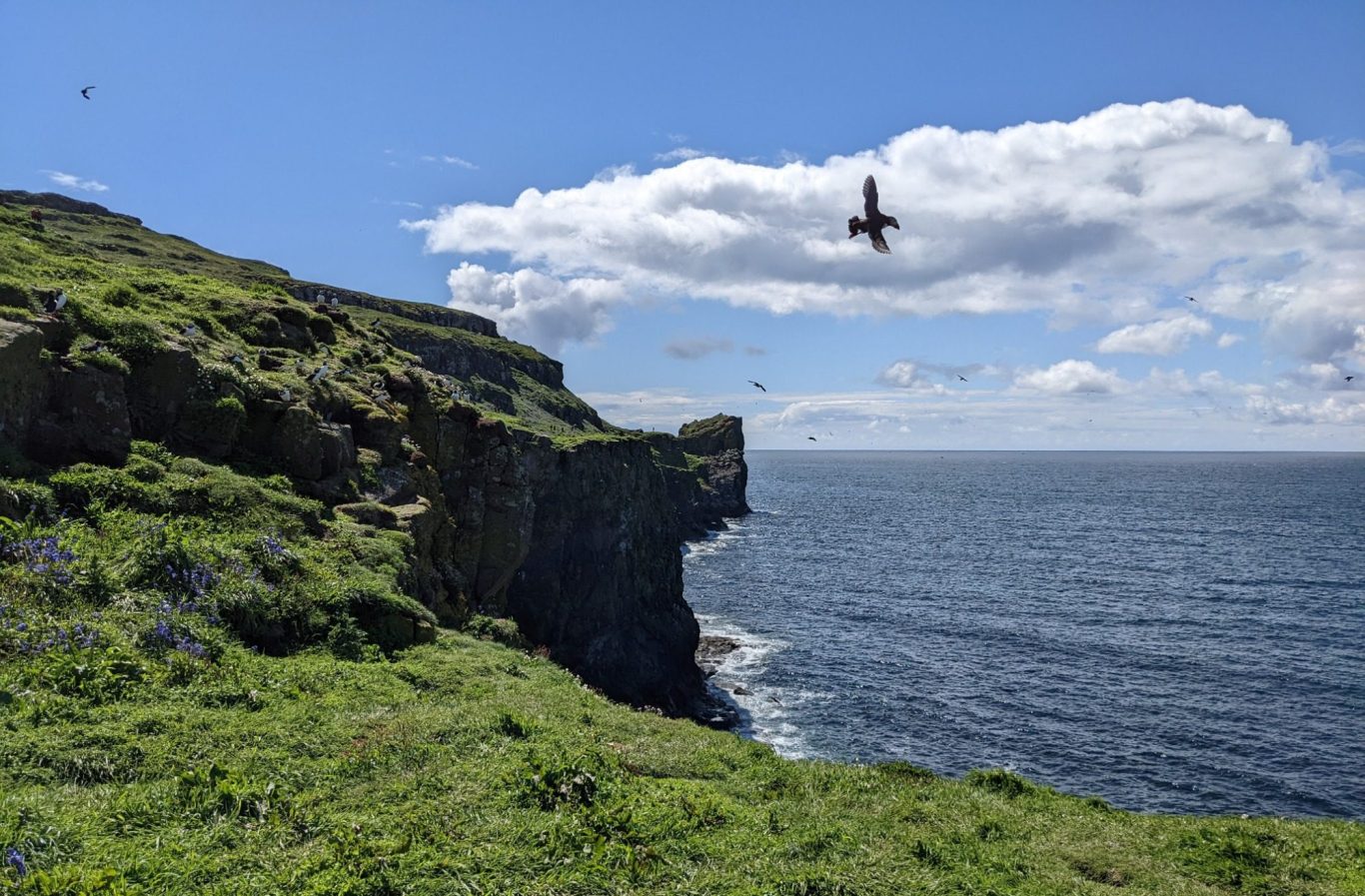
Flora & Fauna
Moments of nature captured by the camera
The first few seabirds presented here are all birds that are mentioned in Rosie and the Secret of the Snogard and I knew very few of them when I first started to become properly interested in wildlife.
A lot of the information provided below, was absorbed over the course of many years of reading, when visiting nature reserves and by speaking to guides and volunteers or fellow observers. For a more detailed exploration I recommend looking at the many amazing nature books available in these Isles and websites like those of the RSPB, Woodland Trust, Wildlife Trusts etc.

Puffin (Fratercula arctica)
The puffin, also known as Tammie Norrie in Orkney or Tammy Norie in Shetland, is one the most iconic seabirds in the UK and one of the most rewarding to watch.
Puffins are extremely curious, sociable and seem to give you that 'aww' feeling as soon as you lay eyes on them. If you are close to a colony and see people staring down a cliff with an adoring expression and a look of wonder on their faces, chances are they spotted a puffin.
Puffins lay their single white egg in burrows or nests in rock crevices and will emit soft growling noises - like mini-bears - when on their egg, which can make a colony sound very loud.
A quartet of puffin facts that I find particularly interesting are: 1) that they spent the majority of their lives (8-9 months) out on the Atlantic ocean and only return to our coasts to breed and raise their young, 2) that the colourful beaks they are so known for, are part of their breeding costume. In winter their beaks are smaller, their eyes more rounded and their feet less bright. 3) that a young puffin is called a 'puffling' and 4) that they tend to mate for life and meet up with their mate at the same place they left the year before. They are incredible birds!
For anyone interested in more puffin facts, there is an excellent RSBP Spotlight Puffins by Euan Dunn, which offers a great overview of these lovely birds. A stunning photographic illustration can be found in Kevin Morgans' book Puffins - Life on the Atlantic Edge.
Fulmar (Fulmarus glacialis)
Often mistaken for a gull by those who haven't seen it before, the fulmar belongs into the family of petrels and shearwaters and is more closely related to albatrosses than gulls.
Like many seabirds it has one brood with a single egg per year.
If you are able to look at it more closely, you will notice the distinctive 'tubenose', which allows it to secret salt from its body after drinking seawater.
It seems serene - when spotted on the cliffs undisturbed - but it has a fascinating defence mechanism, which is to eject a foul-smelling oily liquid at potential predators getting too close to it.
It is an amazingly skilled flier and appears to glide through the air effortlessly. The pearly grey upper plumage and flight pattern makes it easy to learn to distinguish it from gulls.
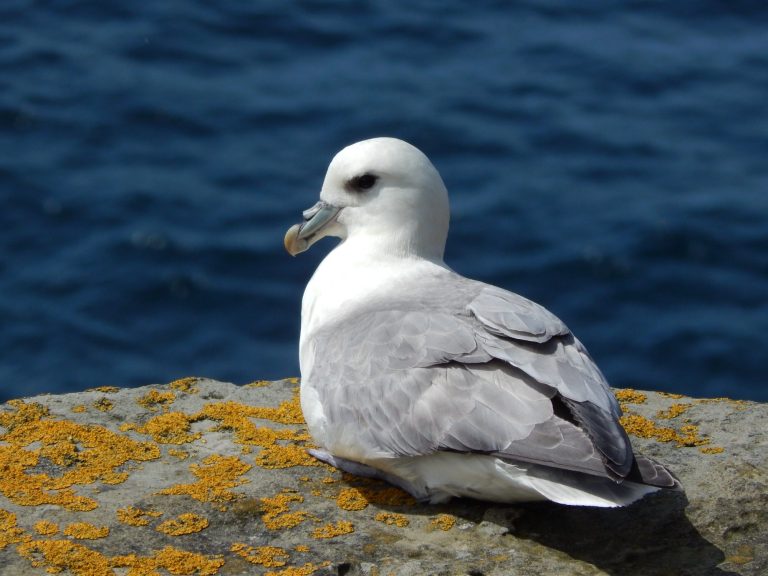
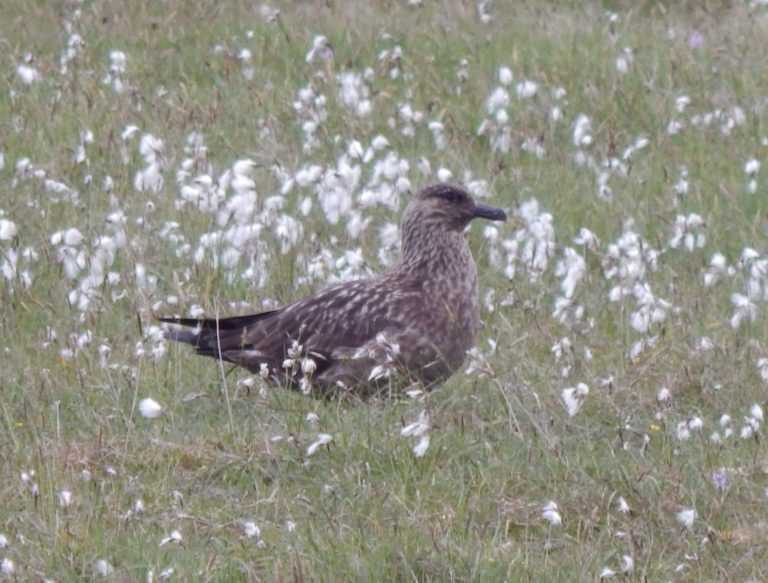
Great Skua (Stercorarius skua)
I would be lying if I said that this is one of my favourite seabirds. But despite my personal views on its lifestyle, the Great Skua (also known as 'Bonxie' in Shetland) is certainly one of the most impressive and terrifying seabirds.
As the largest skua, it has a wingspan of between 1.25 - 1.4 metres and sports bold white patches on its outer wings. Due to its size alone, it is an absolutely fascinating but not exactly comforting sight.
You will sometimes hear it referred to as the 'pirate of the seas' due its habit of kleptoparasitism, which basically means that it steals food off other birds. It also kills birds (up to the size of a kittiwake), eats offal, carrion and eggs.
It has one brood a year with two eggs and tends to breed on moorland or grassland. Wildlife should not be disturbed at the best of times, but the Great Skua is a ferocious defender of its eggs and young and may charge at or dive-bomb you if it feels threatened, so it is highly advisable not to get too close.
Anyone interested in finding out more about skuas and Shetland birds in particular, may want to turn to Paul Harvey and Rebecca Nason's beautiful guide book Discover Shetland's Birds: A Photographic Guide to Shetland's Breeding, Wintering and Migrant Birds
Common tern ( Sterna hirundo)
Terns are very elegant in appearance and the common tern is the one in the family you are most likely to spot inland.
Common terns tend to overwinter on the coast of West Africa and migrate to Europe in spring to raise their one brood of 2-4 eggs. They nest on the ground, preferably on sand or dry earth.
In Shetland common and arctic terns, which are similar in appearance and frequently seen in mixed flocks, are often referred to by their local name 'Tirrick'. This is a good imitation of the very noisy calls they emit. Sometimes you will come across the term 'sea swallow' which accurately describes both their appearance and flight.
They aren't big birds (about 30 cm in length) but a joy to watch.
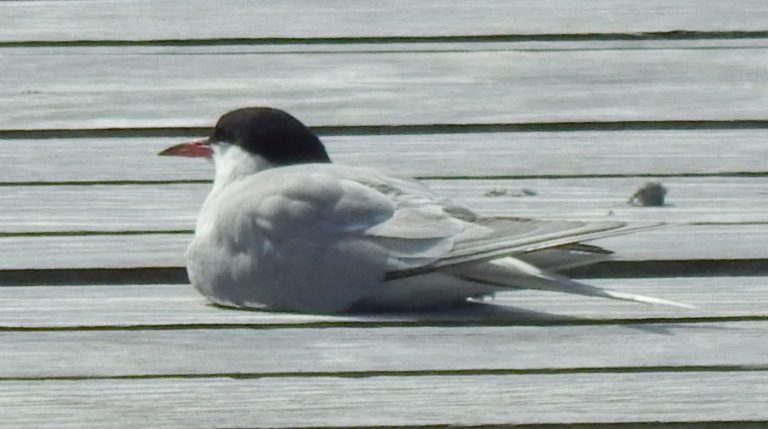

Gannet (Morus bassanus)
The gannet is the largest of the European seabirds and related to pelicans. Adult gannets have a wingspan of 1.65 - 1.8 metres and are amazing fliers.
One of the most fascinating things to watch about gannets is their vertical plunge for food. You will see them seemingly halt in the air, dive down from a great height and - seconds before entry into the water - fold back their wings so their body forms the shape of an arrow. They literally cannon into the water. It is an incredibly arresting sight.
They are highly social birds and form large nesting colonies on rocky outcrops where they appear to be very tightly packed together. The largest nesting colony (or gannetry) in the world is Bass Rock in Scotland. The RSPB's estimate for that colony is roughly 75,000 pairs.
They have one brood with a single egg per year. Young gannets start out as white fluffballs, then moult into uneven black and white plumage with the yellow head of the adult. When they mature their plumage takes on the characteristic white with the black wingtips.
Although there are lots of places to observe gannets in the UK, the most memorable sightings of gannets we've had were Noup Head (Westray) in Orkney and various locations in Shetland.
Orkney's Noup Head offered ample opportunity to observe the gannetry from the cliffs and the birds in flight. In Shetland the Hermaness National Nature Reserve (Unst) allowed us to witness a massive 'wheel' of gannets, the isle of Noss offered a fabulous opportunity to watch them gather nesting material and the Noss Boat tour, run by Phil Harris and Rebecca Nason, took us out to sea to see the gannetry of Noss from a different angle and actually observe gannets dive for fish close to our boat.
Anyone curious to find out about the latter, please see https://www.shetlandseabirdtours.com/
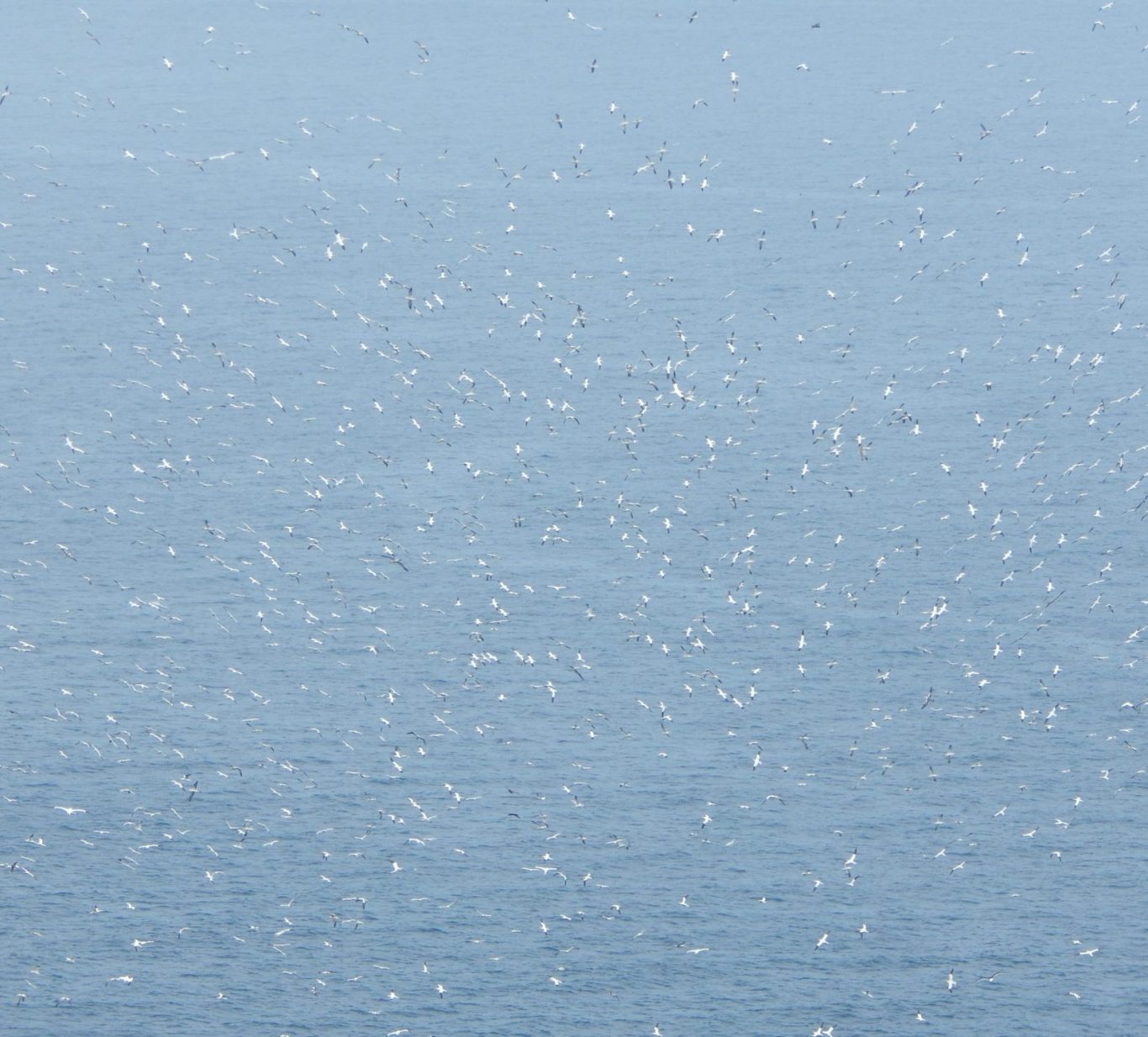
Gannet 'wheel' viewed from Unst, Shetland
This photo was taken at the Hermnaness National Nature Reserve one year in June. I added it to provide an inkling of an impression of the huge gannet wheel, which you can witness up there. The birds were flying in a circular movement and it was one the most spectacular sights of gannets in flight I have seen so far.
Black Guillemot (Cepphus grylle)
Along with the puffin, the black guillemot or 'Tystie' is probably my favourite auk of the four I've seen 'live' so far.
I like the others too - razorbills, especially when swimming under water, and guillemots when they do their sideways belly-up wash-roll in the water - but there is something particularly attractive about the black guillemots' red throat and snazzy red feet during the breeding season. The latter also makes watching them dive real fun, as you usually get to see the feet stick up in the air before they disappear into the water.
The beautiful white ovals on the black wings make them easily identifiable when in flight or at rest.
Black guillemots are not as social as puffins or guillemots and prefer small islets, cliffs or rocky headlands, usually away from large colonies. They tend to dive for fish and crustaceans, usually reaching a depth of 10 to 20 metres, but can get down to 50 metres on a dive.
They lay their one to two eggs into crevices or between large boulders, on occasions even using harbour walls. Like with other auks, the parents share the incubation and feeding duties until the young fledge.
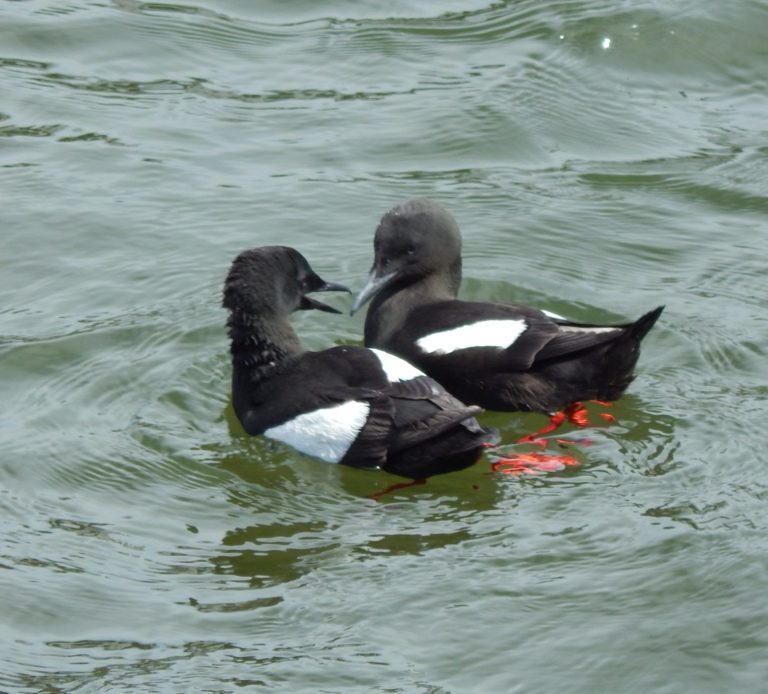

Guillemot (Uria aalge)
Despite being part of a different family, guillemots can sometimes feel like a northern (flying) equivalent to the southern penguins.
These auks form dense breeding colonies on sheer bare cliffs and it is amazing that their single egg (due to their special shape) doesn't just tumble off and down into the sea.
Unlike with puffins or black guillemots where the young fledge and literally fly the nest, guillemot chicks (like their razorbill cousins) are expected to jump off their home cliff and into the sea below. At that stage they are not yet fully grown and still flightless.
This usually happens at dusk (for safety) when they are about 2-3 weeks old. The fathers, who usually wait for the 'jumplings' in the sea under the cliffs, will escort their youngster out to sea and look after it until it is fully grown.
Guillemot colonies are places that teem with birds and can usually be heard and smelt when still some distance away.
One of the many things I love about guillemots is the rafts they form out at sea. There you can usually spot a few of them doing a sideways belly-flop wash which is highly entertaining to watch.

Guillemot colony at Noup Head, Westray, Orkney
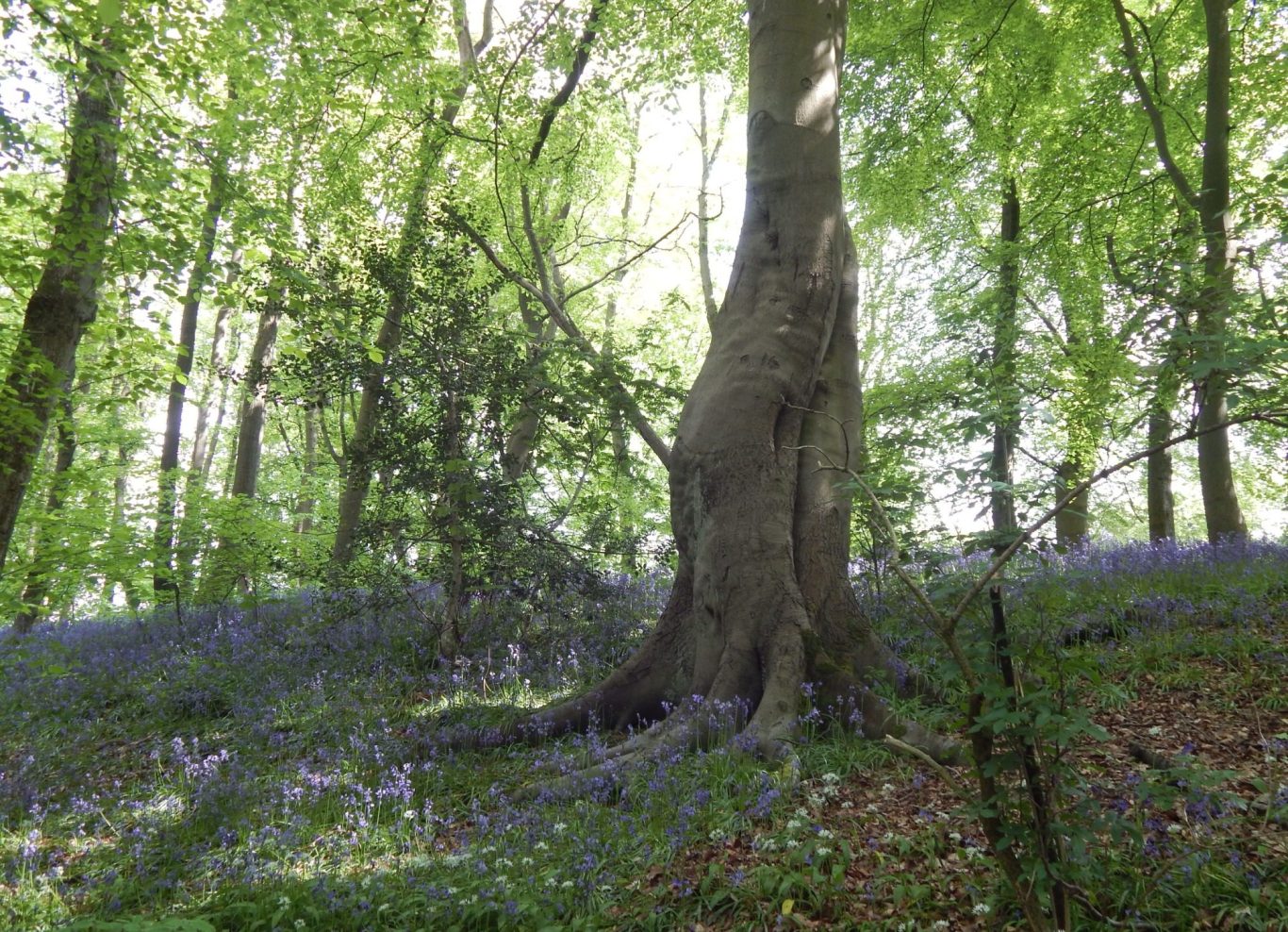
Bluebell wood at Shibden Hall, close to Halifax, Yorkshire
Bluebells (Hyacinthoides non-scripta)
These bluebells, not to be confused with the so-called Spanish bluebell which has a more robust and upright growth, are native to the British Isles and some other parts of northern Europe.
They are often an indicator of ancient woodland and usually flower from Mid-April to May (June if you are further north). They have a sweet scent and tend to nod to one side.
If you are so lucky as to find yourself in a wood with bluebells in late spring, you will be able to admire a beautiful blue carpet of these flowers. They are very popular with pollinators.
Occasionally you may see some white or pink blooms among the blue ones. These are bluebells too but show a slight variation in colour.
According to the Woodland Trust they have many different names. My favourites among those are lady's nightcap and fairy flower. You could just picture a tiny fairy wearing a bluebell bloom as a fancy head. That being said, they are a rare and protected species so please don't pick them and try to avoid standing on them too.
I hope you'll get a chance to see these beautiful plants. It is also worthwhile to check hedgerows, as they sometimes grow - slightly hidden - in the shade of a hedge.
Please check in again for further posts.
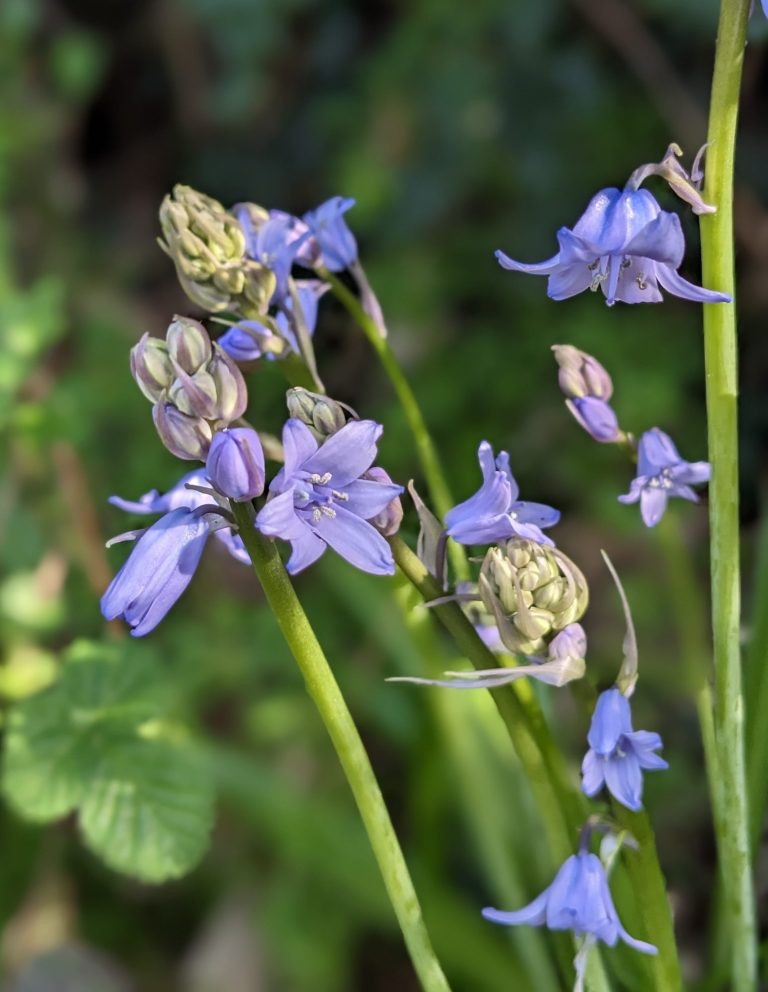
© Copyright 2024-2025. All rights reserved. Designed by Eva for TRAIGH BAN
We need your consent to load the translations
We use a third-party service to translate the website content that may collect data about your activity. Please review the details in the privacy policy and accept the service to view the translations.